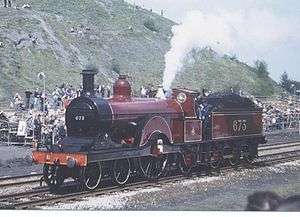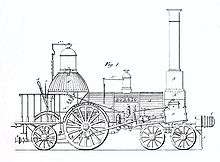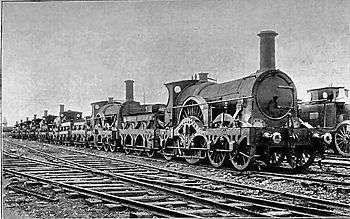4-2-2

Under the Whyte notation for the classification of steam locomotives, 4-2-2 represents the wheel arrangement of four leading wheels on two axles, two powered driving wheels on one axle, and two trailing wheels on one axle.
Other equivalent classifications are:
UIC classification: 2A1 (also known as German classification and Italian classification)
French classification: 211
Turkish classification: 14
Swiss classification: 1/4
Like other steam locomotive types with single pairs of driving wheels, they were also known as singles.
History

The 4-2-2 configuration offered designers eight wheels to spread the weight of a larger locomotive, but prior to the introduction of bogies, created a long rigid wheelbase with limited adhesion. As a result, the type was relatively rare until the 1870s. The first steam locomotive made by Borsig of Berlin in 1841, the Borsig No 1, was an 4-2-2, but the company quickly reverted to the more common 2-2-2 configuration.
UK developments
The London and North Western Railway No. 3020 Cornwall was built as 4-2-2 at Crewe in 1847, but was extensively rebuilt, and converted to a 2-2-2 in 1858.

The one area where the type proved to be useful was on broad gauge locomotives, where sharp bends were less of an issue. Daniel Gooch built 29 examples of his Iron Duke express locomotive class for the Great Western Railway between 1847 and 1855.[1] They had an 8 ft diameter driving wheel size. Twenty examples of a similar design were built for the Bristol and Exeter Railway after 1849, by Stothert and Slaughter in Bristol.[2] Because both sets of leading wheels are mounted independently in the frames in these classes, they are sometimes described as (2-2)-2-2 rather than 4-2-2.[3]
The first 4-2-2 to have a bogie was built by Archibald Sturrock of the Great Northern Railway (GNR) in 1853. This had 7 ft 0 in (2.134 m) flangeless driving wheels, and was only moderately successful, having a tendency to derail.[4] By the 1870s, improved design of bogies giving more flexibility enabled designers to create fast standard gauge express passenger locomotives of this type. On the GNR, Patrick Stirling built 53 examples with outside cylinders at Doncaster railway works between 1870 and 1895, for use on the main line between London and York. They ran at an average speed of more than 60 mph during the race to the north, and were called eight-footers because of the driving wheel, that was more than 8 ft. in diameter. Stirling's successor Henry Ivatt built a further twelve singles between 1898-1901 before moving on to larger 4-4-2 designs.
Following the success of the Great Northern designs, the Midland Railway introduced the inside cylinder "Spinners". Eighty-five were built to five designs by Samuel W. Johnson between 1887 and 1900.[5] One 115 class, No. 673, survives at the National Railway Museum, York. William Dean of the Great Western built fifty examples of the standard gauge GWR 3031 Class Achilles class from 1893-1899.[6] No 3065 Duke of Connaught contributed to the record-breaking run of the Ocean Mail express train from Plymouth to Paddington in 227 minutes on 9 May 1904, when it took over the train at Bristol from No 3440 City of Truro and completed the journey to Paddington in 99 minutes 46 seconds.
Other notable UK examples are the unique Caledonian Railway single No.123, which has been preserved, and the GER Class P43, which was an early oil-burning engine, developed by the pioneer of oil-boilers, James Holden
US developments

The T.D. Judah locomotive was built as a 4-2-4 by the Cooke Locomotive Works in 1863. It was purchased for use on the Central Pacific Railroad and in 1872 was rebuilt as a 4-2-2.
By 1900 typical loads on express trains had grown beyond the capabilities of 4-2-2 locomotives and the configuration was superseded by the 4-4-2.
References
- ↑ Bertram Baxter, British Locomotive Catalogue 1825-1923, Vol.1, Moorland Publishing, (1977), p. 55.
- ↑ Baxter (1977), p. 53.
- ↑ Science Museum, The British Railway Locomotive 1803-153, H.M.S.O., 1958, p.14.
- ↑ Casserley, H.C. (1960). Historic locomotive pocket book. London: Batsford. pp. 15–16.
- ↑ Baxter (1977), p. 55.
- ↑ Baxter (1977), p. 57.
External links
- Winchester, Clarence, ed. (1936), "Some famous singles", Railway Wonders of the World, pp. 1091–1099 illustrated description of some famous singles